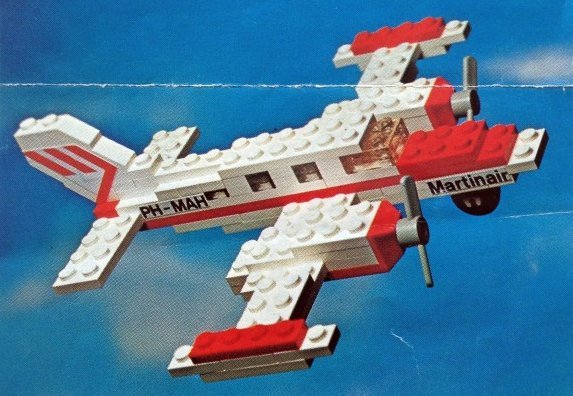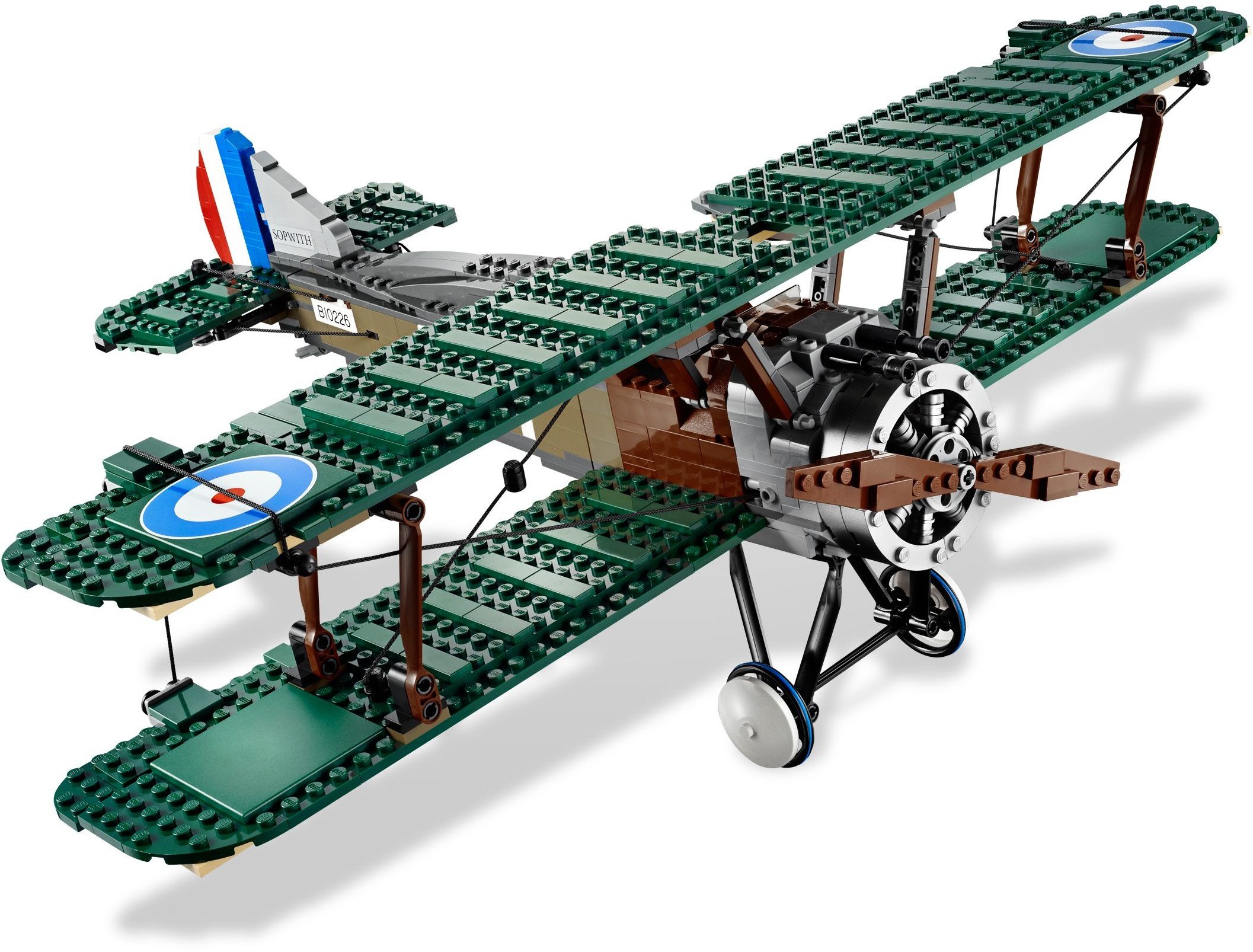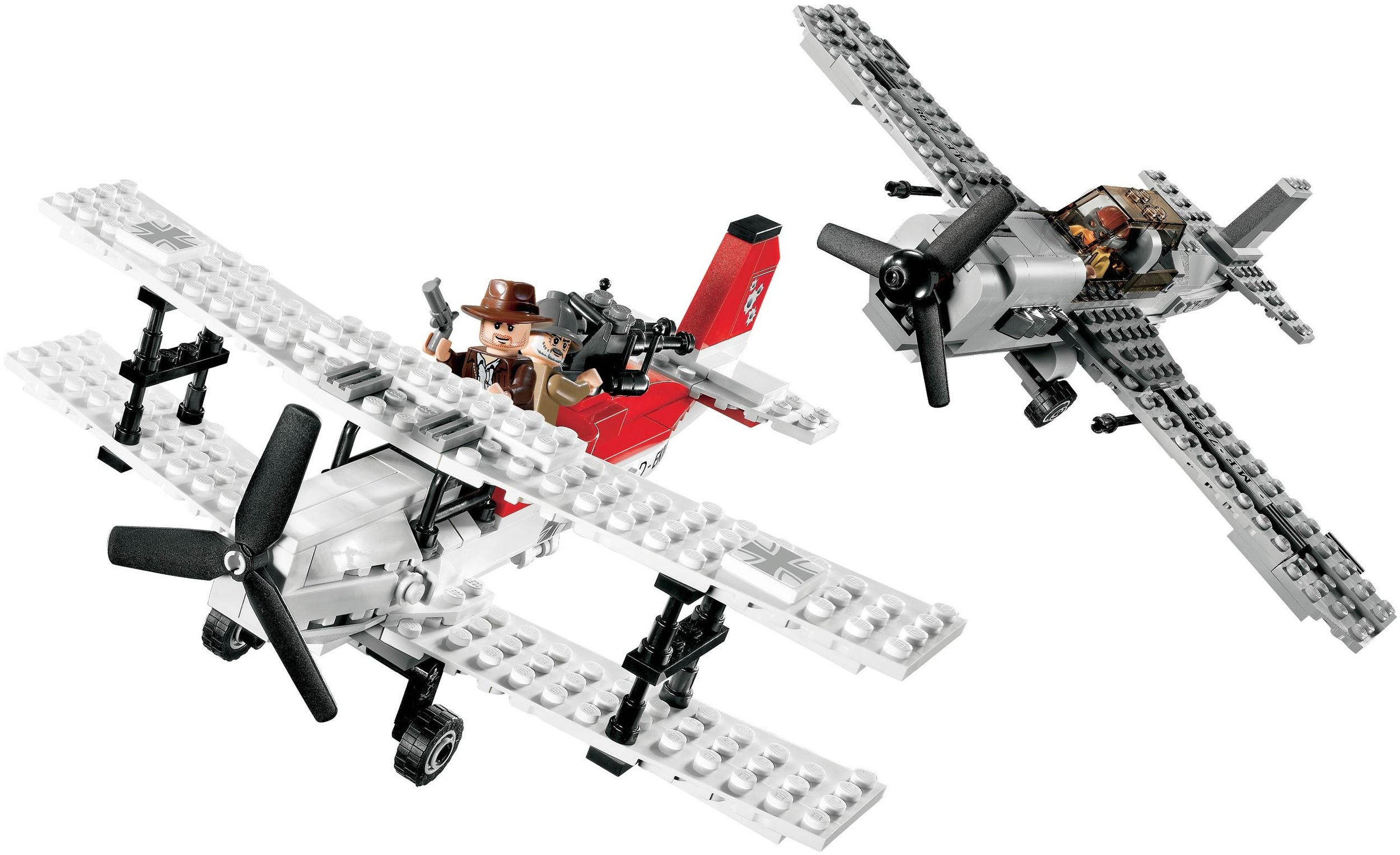Everything You Want to Know About LEGO Model Airplanes
/The release of LEGO’s new iconic Concorde set got me all excited about model airplanes in LEGO sets, so I went down into the archives to look at what’s come before. Just like in my previous article about model ships, I won't cover minifig sets with airplanes (there are a LOT of them!). Instead, I will focus on models of real-life airplanes. I'll also limit myself to airplanes with wings, leaving helicopters for another day.
So, how far do we need to go back in time to find the first airplane set? The answer may surprise you...
The Early Days
Basic airplane designs in set 311 from 1962 - Image from Peeron
As far back as 1950, a set with just 2x4 bricks shows an image that vaguely resembles an airplane. This is in the days before tubes and clutch power! You can’t call this a model of an airplane, though. Then, in 1961 (or 1962? Brickset and Peeron don't agree) LEGO released set 311, a dedicated set with airplanes. The set featured very rudimentary shapes but it was a definite improvement over 1950, and thanks to the introduction of the tubes under the bricks, these planes were swooshable.
Then in 1965, set 320 was released: a model of LEGO's first corporate plane, a Piper PA-23-250. The length and wingspan are proportional and suggest a scale of 1:40. The fuselage is a bit too narrow and tall, but the livery is clearly taken from the OY-FAV.
Set 320 “Airplane” - Image from Brickset
LEGO Corporate plane, registration OY-FAV - Image from Danish Register of Civil Aircraft
The 70s - The Era of Classics
The story continues in 1970 with the oddly named set 346 'Jumbo Jet', which clearly is a Concorde. It is also odd that while Concorde was a cooperation between the French and the British, the set was produced by Samsonite and only released in the USA.
Set 346 “Jumbo Jet” - Image from Brickset
Another odd thing is the width. Without jumper plates, there was only one way to get the tail fin in the middle of the fuselage… and that was making it three studs wide, so that's what they did. Considering that everything in those days was 4, 6 or 8 studs wide, this was quite unusual. While it may look crude now, I think the designer did a pretty good job considering the parts palette at the time.
Set 687 “Caravelle Aeroplane” - Image from Brickset
The Jumbo Jet/Concorde set must have sold well because it kick-started a wave of airplane sets throughout the 1970s, starting with the Sud Aviation Super Caravelle. First available in 1972 as promotional set 1550 for Danish airline Sterling, it was followed a year later by an unbranded version in set 687. Though officially unbranded, the logo on the tail looks like it was inspired by Dutch airline Martinair (more about them later). Both planes had a printed tail fin and used the same printed 2x4 bricks with a red stripe and four windows.
Set 1552 “Sterling Boeing 727” - Image from Brickset
In 1974, LEGO went back to Sterling for inspiration (or Sterling came back to LEGO) and this time, the subject was the Boeing 727. It was a more modern plane with more and smaller windows, so a new print was developed. Unfortunately, the new print wasn't ready when they took the photo for the instructions, so it shows a development model with the window prints from the Caravelle. The image on the box uses the correct window print.
This set used a brand new element for the tail fin which was printed with the Sterling logo. When the Boeing 727 was rereleased two years later as promotional set 1560 for Lufthansa, the tail was produced in blue, and this time the logo was a sticker (probably because printing yellow on blue wouldn't work at the time). While this set looks the same, the build is slightly different. The Lufthansa livery required the stripe with the windows to be on the lower third of the 2x4 bricks rather than the middle, so a row of plates and a row of bricks have swapped places.
The 727 had one more outing as a regular set, but in the colours of JAL in set 698, going back to the original build with white bricks with the windows printed in the middle.
Meanwhile in 1974, LEGO also released set 657. Brickset calls it "Aircraft" while the 1974 UK catalogue calls it "Executive Jet." That name may be a hint to the inspiration for this set which looks quite different than the Caravelle, despite using the same window print. That shape made a lot more sense two years later in set 455 “Learjet.”
Set 455 “Learjet” - Image from Brickset
This set has the same overall shape as 657, but the engines have moved forward and it uses clear plates instead of the printed windows. This model is most likely based on LEGO's own corporate jet, a white Learjet 25.
LEGO Corporate Jet, a Learjet 25 with registration OY-AKL - Image from the Danish Register of Civil Aircraft
These two sets leave us with some questions: Why was the generic version released first, unlike the Caravelle and Boeing 727 where the branded/ promotional version came first? Why did the first version use the printed windows from the Caravelle? Why was the white version released four years after LEGO had sold its real Learjet? Why was it a US-only release (according to LEGO fan and casual historian Gary Istok - there's no mention of it on Brickset)? We'll probably never know.
Set 1562 “Biplane” - Image from Brickset
Alongside these modern planes, LEGO also produced two historic ones in 1976. The first one was 1562, another Lufthansa promotional set. It was a fairly crude biplane, probably inspired by Lufthansa's own Antonov AN-2.
Set 661 “Spirit of St. Louis” - Image from Brickset
The second one, set 661 in Europe and set 456 in the US, was based on the famous Spirit of St. Louis, Charles Lindbergh's plane that made the first non-stop transatlantic crossing from New York to Paris. Both models should have been grey to be true to their respective prototypes, but that wasn't yet a popular main colour for sets. The Lufthansa plane was made blue while the Spirit was yellow. The colour wasn't the only issue though; it also has the wrong propeller and the wings are way too small. That means it wasn’t quite a scale model then, but that really didn’t bother seven-year-old me.
The Legoland aviation theme ended in 1978 with three more promotional sets. First up is set 1555, the last collaboration with Sterling. This time, it's a biplane with registration OY-VET. While it's a nice-looking plane, it probably isn't based on a real plane. I have found no record of Sterling ever having a biplane, and there was never a plane with registration OY-VET.
Set 1610 “Airliner” - Image from Brickset
Next are two sets produced for Dutch charter airline Martinair (founded in 1958 by a neighbour of my grandmother). Both sets share the made-up registration PH-MAH. The small propeller plane is a model of a Cessna 402B. The real plane had registration PH-MAZ. It’s the plane you see on Wikipedia, only in its new livery after being sold to the Dutch Department of Waterways.
The jet is a McDonnell Douglas DC-9. A special window print was created for this set. It’s similar to the previous ones but the colour band is wider. With no available tail piece in the right shape, both of these sets have brick-built tail fins. It works on the Cessna, but at the scale of the jet, it looks a bit clunky.
The 80s and 90s - A Long Wait
After the bonanza in the 1970s, LEGO’s airplane production came to a halt. Ten years after the Martinair sets, there was an Air Canada promotional set. Possibly meant to resemble a Boeing 767 but the proportions are more than a bit cartoonish; the tail fin and wings are too small or the fuselage too big. It's a minifig airplane without the minifigs. The same year, Technic also released its first airplane set, a generic propeller plane.
During the 1990s the closest thing to a model airplane was part of Model Team set 5591 Mach II Red Bird Rig, but the bird in question was a generic show jet, not modelled on a real plane. There were some more Technic planes, but all generic and mostly not very interesting.
The 00s - A New Hope
In 1999. The LEGO group started making Star Wars sets, and the year after they released two enourmous sets, starting the now-famous Ultimate Collector Series. This was a clear sign that they saw the potential of selling sets to adults. Also that year, they produced a Lady Liberty statue (3450) and a scaled-up minifigure (3723). Then in 2001, out of nowhere came set 3451 Sopwith Camel, a fighter plane from World War I.
Set 3451 “Sopwith Camel” - Image from Brickset
This was a proper scale model of a real-world airplane. The scale, 1:15, is much larger than any airplane set before it. A year later, set 10024 Red Baron was released on the same scale. This is another fighter plane from the same year, 1917: the Fokker Dr.I triplane.
For the next installment in the series, LEGO returned to the beginning of human flight with the Wright Flyer, the plane with which Orville Wright first flew 120 ft… or just over half the length of a Boeing 747!
Set 10124 “Wright Flyer” - Image from Brickset
For this plane, the length was roughly at the same scale as the previous two but the wingspan was much too small at a mere 68 studs. To be to scale, the wingspan would have to be 120 studs. One funny detail: when it was released, this set had more Technic chain links than any Technic set (excluding Dacta and service packs). Twenty years later, that number has been surpassed by the Haunted House, two Roller Coasters and the Razor Crest UCS set—there still isn't a Technic set with more chain links.
A few years later, LEGO went to the other extreme with set 10177, based on the then not-yet-released Boeing 787 Dreamliner in 1:87 scale (measuring a respectable 82 studs long with an 86 stud wingspan), but that was the last of the large plane models for a while.
Set 10177 “Boeing 787 Dreamliner” - Image from Brickset
In 2007, Creator started their series of 3-in-1 airplane sets with 4953 Fast Flyers. This model appears to be loosely based on an F-14 Tomcat. To make sure it doesn't look like the military fighter jet it is it has the colours of a fictitious show-squadron. The type of plane and the size of the set varies, but the 3-in-2 series continues to this day, the latest installment so far being set 31126 Supersonic Jet from 2022.
The 10s - The Sequels
“Spirit of St Louis”, exclusive store opening set - Image from Brickset
The 2010s started with two LEGO Store opening exclusive airplane sets. One was an anonymous cargo plane (perhaps a Boeing C-17?), and the other was a more familiar subject, the Spirit of St. Louis. This time the colour is correct in mostly grey, but despite having nearly double the parts count, it is actually smaller than the 1976 set. (You wonder why they didn't save this set for the opening of the West County Center store. The Spirit was after all named after Charles Lindbergh's hometown of St. Louis, MO.)
The next model to be revisited was the Sopwith Camel in 2012. Set 10226 has different colours than 3451 plus working steering! The stick in the cockpit actually moves the wing ailerons and tail flaps. As a bonus, there was also a 65-piece polybag version.
10226 Sopwith Camel - Image from Brickset
Also in 2012, LEGO created the most exclusive set on this list with a model of the old corporate Piper plane for that year's LEGO Inside Tour set. (You can read more about that set in BrickNerd’s article series about LEGO Inside Tour sets.) In 2015, a copy of set 4000012 was sold for $4,350 on eBay, and in 2020, one sold for €3,050 on Catawiki. There's currently a used one on eBay for a mere $2,500.
Set 4000012 “Piper Airplane” - Image from Brickset
For the last airplane model in this decade we return to Lufthansa. Set 40146 is one of the smallest sets in this overview, and ironically it’s a model of the Airbus A380, the world’s largest passenger airliner.
The 20s - The Return of...
Set 40450 “Amelia Earhart Tribute” - Image from Bricket
The 2020s almost started with the first Technic model of a real aircraft, but set 42113 Bell-Boeing V-22 Osprey was cancelled at the last moment. Instead, the first model in the 2020s was set 40450, a tribute to Amelia Earhart and her Lockheed Vega 5C. The model is at a scale of around 1:50, similar to the first Spirit of St. Louis set, but being created 45 years later means it's more detailed. The set also includes a minifigure of Amelia.
This brings us to 2023 and the release of the enormous set 10318, the iconic Concorde. At just over a meter long (3'5") and containing over 2,000 parts, this is easily the biggest airplane model set to date—and based on reviews, it appears to be a fantastic set to build.
Set 10318 “Concorde” - Image via LEGO
Like the Dreamliner, the livery is that of the manufacturer’s demo rather than one of the two customers, Air France or British Airways. I suspect it would have cost too much to include parts for both airline liveries, and they couldn’t pick one over the other.
So there we are. Over nearly 60 years, LEGO has produced models of the world’s first, biggest, and fastest planes, as well as some less famous ones in all sizes and scales varying between 1:15 and 1:500.
Epilogue
Ok, I said no minifigure sets, but I'm going to make an exception for Indiana Jones. In 2008, the release of the fourth Indy movie Kingdom of the Crystal Skull prompted a number of sets including 7628 Peril in Peru which contains a very nice Douglas DC-3. While it's a little small (its scale is around 1:65, while 1:40 is considered minifig scale), its proportions are pretty good for a play set.
The Douglas DC-3 from set 7628 - Image from Brickset
In the second wave in 2009, we have set 7683 which features a flying wing. It's not a great likeness of the movie plane, which itself was a made-up movie prop. Enough said about that. There was another set, 7198 Fighter Plane Attack, that contained two planes. First up is the plane that Indy and his dad steal from the zeppelin. This is supposed to be a Bücker Bü 131, but the actual plane used in the movie is a Belgian Stampe et Vertongen SV.4C. For a minifigure set, it's actually a little too long and its wings are a little short, but it's recognisable.
Set 7198 “Fighter plane attack” - Image from Brickset
The second plane is the one that's chasing the Jones's. It's meant to be a German Messerschmitt Bf 109, but out of necessity, the studio used a Swiss Pilatus P2 in the movie. This model is also too big for minifigure scale but that's probably because of the mechanism for its party trick: press down on the cockpit and the wings pop off. The model in the set is based on the P2 but has the correct propeller for a Messerschmitt.
The plane from set 77012 - Image via LEGO
With the release of the fifth Indiana Jones movie this year, there’s another wave of Indy sets and one of them, set 77012, contains a new version of the Pilatus P2. This set depicts a later scene in the movie where it's chasing a car, so there's only a single plane in this set. The length is spot on this time, but the wingspan should have been six studs wider. The propeller is again wrong (four blades this time), the exhausts are exaggerated and those stud shooters on the wings don’t help, but it's still a much better model than the first one. (Oh, and the swastika on the tail fin is missing, thankfully… unlike the some concept art from 2009.)
This is where the deep dive into the archives ends. Time to come up for air. Where will the story of LEGO airplane models go next? Will this be the start of a new string of releases like 20 years ago? We’ll just have to wait to find out.
Best of BrickNerd - Article originally published September 4, 2023.
What LEGO model airplane sets are your favourites? Let us know in the comments below.
Do you want to help BrickNerd continue publishing articles like this one? Become a top patron like Charlie Stephens, Marc & Liz Puleo, Paige Mueller, Rob Klingberg from Brickstuff, John & Joshua Hanlon from Beyond the Brick, Megan Lum, Andy Price, Lukas Kurth from StoneWars, Wayne Tyler, LeAnna Taylor, Monica Innis, and Dan Church to show your support, get early access, exclusive swag and more.































